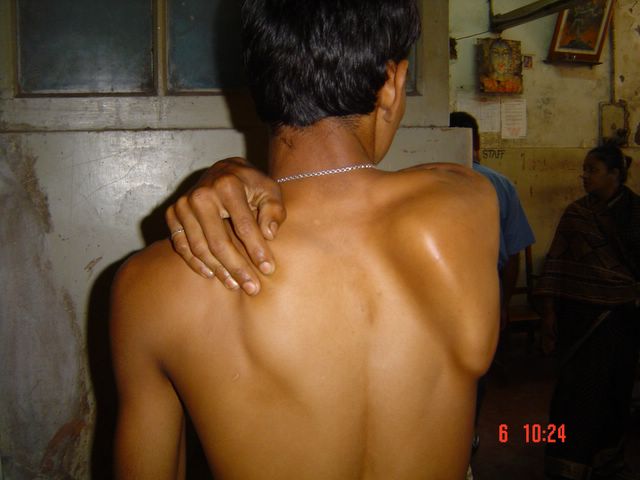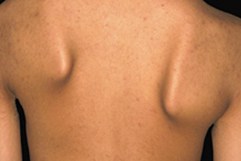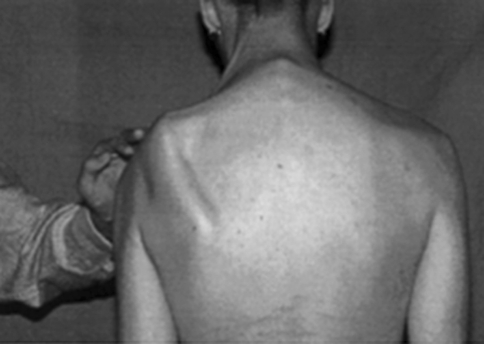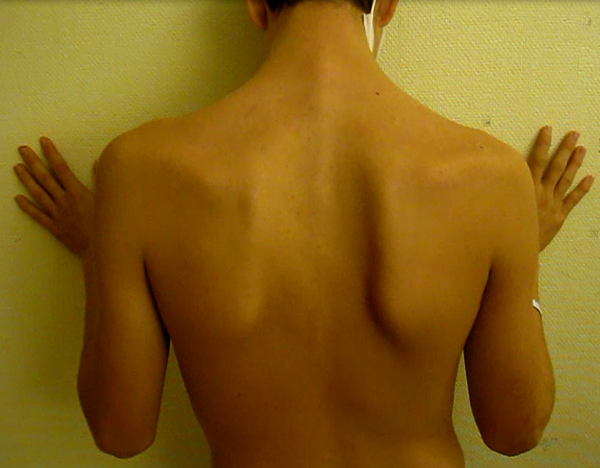Winged scapula refers to a shoulder blade that sticks out like a wing.
True scapular winging is a rare disorder that results from nerve injury and the associated weakness of the shoulder blade muscles.
Prominent shoulder blades in infants and toddlers and individuals with the skinny body, poor posture with rounded shoulders, unbalanced muscle building, scoliosis or kyphosis, in most cases, are not examples of true winged scapula and do not cause any problems.
Symptoms
Symptoms associated with true scapular winging [7]:
- Dull pain in the shoulder blade (usually only one), which may radiate down the arm and may be aggravated by pressing the upper back against chair
- Shoulder pain or instability
- Pain at the back or side of the neck
- Difficulty lifting the shoulder (shrugging), lifting the arm forward and pushing or pulling heavy objects
Winged scapula can present without any pain or other symptoms. The winging may become apparent only several weeks after an injury [7].
Signs
In medial scapular winging, the medial border of the scapula sticks out, the scapula is elevated and displaced medially (Picture 1, Video 1); the forward arm lifting above the shoulder level is limited [7].
Picture 1. Medial scapular winging (on the right)
due to an injury to the long thoracic nerve
(source: Wikimedia, CC license)
Video 1. Medial scapular winging due to long thoracic nerve injury
and serratus anterior palsy – anatomy, symptoms
Bilateral scapular winging can occur in a rare hereditary disorder facioscapulohumeral muscular dystrophy (FSHD) (Picture 2) [15].
.
Picture 2. Bilateral scapular winging in
facioscapulohumeral muscular dystrophy
(source: FSH Society)
In lateral scapular winging, the superior angle (in trapezius palsy, Picture 3) or the inferior angle (in rhomboid palsy) of the scapula is displaced laterally [7].
Picture 3. Lateral scapular winging due to
trapezius palsy (on the left)
(source: OPENi)
Causes
Medial scapular winging usually results from damage to the long thoracic nerve and the associated weakness of the serratus anterior muscle.
Traumatic causes [4,7,10]:
- Repetitive arm stretching in athletics, gymnastics, boxing, weightlifting, baseball, swimming, garden digging, etc.
- Pressure from backpack straps, bra, harness or armpit crutches
- Blunt trauma of the shoulder or the side of the ribs
- Compression of the C7 spinal nerve by a herniated disc
- Deep tissue massage, chiropractic manipulation, a muscle injection or inserting a tube through the chest wall
- Surgical removal of the lymph nodes in the armpit
- Birth injury
Non-traumatic causes [6,7,11]:
- Inflammation of the brachial plexus (brachial neuritis, Parsonage-Turner syndrome)
- Viral illness: influenza, infectious mononucleosis or poliomyelitis
- Drug overdose or allergic reaction to drugs
- Congenital disorders: facioscapulohumeral dystrophy [6], aortic coarctation or Ehlers-Danlos syndrome [16]
- A scapular tumor
Lateral scapular winging can result from [4,5,7]:
- Damage to the spinal accessory nerve during surgery or blunt trauma at the back of the neck resulting in trapezius muscle palsy
- Impingement of the dorsal scapular nerve in volleyball players resulting in rhomboid major or minor muscle palsy
- Compression of the 5th cervical nerve
- Repeated shoulder joint dislocation
Diagnosis
A doctor, usually an orthopedist, can recognize winged scapula during a physical examination (Picture 4).
Picture 4. A wall push-up test for winged scapula.
Stand 2 feet from a wall, lean toward it and press against it with your hands [4].
Note a winged right scapula vs. normal left scapula.
(source: Physio-pedia, CC license)
Electromyography (EMG), nerve conduction tests and neuromuscular ultrasound can help to identify the affected muscles and nerves [3,17].
Treatment
Pain Relief
To reduce pain, apply an ice pack to the shoulder blade for 10-15 minutes few times a day and avoid overhead arm activities [1,7].
Transcutaneous electrical nerve stimulation (TENS), nonsteroidal anti-inflammatory drugs (NSAIDs), narcotic analgesics, steroid injections, nerve blocks and acupuncture probably do not reduce pain significantly [7,13].
Serratus Anterior Palsy Treatment
Physical therapy is often effective; it can last for 6-24 months and can include [1,7,8]:
- Passive stretching of the rhomboids, levator scapulae and pectoralis minor muscle by a therapist
- Strengthening exercises for the trapezius muscle (when the pain subsides)
- Wearing a scapula winger’s brace [12,13]
Surgery can be considered when the symptoms do not improve with conservative treatment in 12 months after a traumatic cause or 24 months after a non-traumatic cause [8,9].
- The release of the long thoracic nerve (neurolysis) has had excellent results, so far [7,14].
- Transfer of the pectoralis major muscle from the humeral head to the inferior angle of the scapula can be effective in physically less active individuals [7].
- Fixation of the scapula to the ribs by wires (scapulothoracic fusion) is considered a palliative treatment and results in a limited range of motion in the shoulder [9].
Trapezius Palsy Treatment
A shoulder orthosis may help in damage to the accessory nerve after neck surgery [7]. Physical or chiropractic therapy probably do not help [7,13].
Surgery [7,9,10]:
- The release of the accessory nerve can be effective if performed within 20 months of injury.
- Transfer of the insertion ends of the levator scapulae muscle to the acromion or the rhomboid muscles to the infraspinatus fossa of the scapula (the Eden-Lange procedure) is often effective but less likely after nerve damage caused by neck surgery.
Rhomboid Palsy Treatment
Rhomboid muscles palsy due to damage to the dorsal scapular nerve can be effectively treated by [7,9]:
- Cervical collar
- Cervical traction
- Strengthening exercises for the trapezius muscle
- Massage (after rhomboid strain)
- Surgical decompression of the dorsal scapular nerve
Recovery Period
In true scapular winging due to nerve injury, you should rest the affected muscles; you should avoid sports, most of the physical work, raising the arm on the affected side above the shoulder and carrying backpacks until full recovery [7].
Symptoms usually resolve spontaneously or with conservative treatment within 9 months of traumatic and within 24 months of non-traumatic injury [2,10]. Recovery after surgery may last from few weeks to 6 months [14].
Recovery is often incomplete. Common complications are permanent scapular winging and decreased range of motion in the shoulder [14].
- References
- Winged scapula Drmillet.com
- Wiater JM et al, 1999, Long thoracic nerve injury PubMed
- Suri M, Long thoracic nerve palsy Mistysurimd.com
- Winging scapula Shoulderdoc.co.uk
- Scapular winging Drmillett.com
- Symptoms of facioscapulohumeral muscular dystrophy FSHsociety.org
- Martin RM et al, 2007, Scapular winging: anatomical review, diagnosis, and treatments PubMed Central
- Moore D, Scapular winging OrthoBullets
- Winged scapula Aetna
- Gooding BT et al, 2013, Scapular winging PubMed Central
- Patel DR et al, 1996, Winging of the Scapula in a Young Athlete PubMed
- Vastamäki M et al, 2015, Scapular Bracing is Effective in Some Patients but Symptoms Persist in Many Despite Bracing PubMed Central
- Galano GJ et al, 2008, Surgical Treatment of Winged Scapula PubMed Central
- Maire N et al, 2013, Long thoracic nerve release for scapular winging: Clinical study of a continuous series of eight patients ScienceDirect
- Giannini S et al, 2007, Fixation of Winged Scapula in Facioscapulohumeral Muscular Dystrophy PubMed Central
- Hypermobility disorders Kidzclinic.com.au
- Krzesniak-Swinarska M, 2017, Neuromuscular ultrasound for evaluation of scapular winging Wiley Online Library





